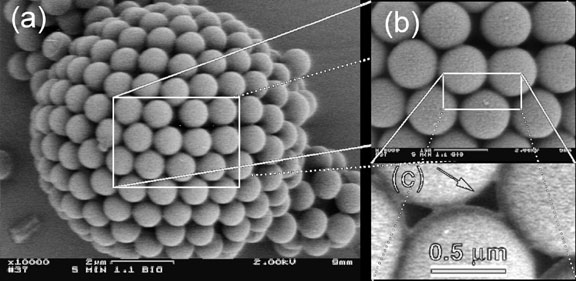Colloidosomes: Self-Assembled Permeable Solid Shells

SEM image of colloidosome, showing the pores that control permeability.
A new approach in exploiting self-assembly
to create novel structures with building blocks of lager length scale was
created in the work of Weitz and his collaborators, who created structures
they call colloidosomes. These structures are made by adsorbing colloidal
particles at the interface of an emulsion droplet, gently sintering the
particles to stabilize the structure, and the by transferring the larger
droplet into a new continuous-phase of fluid which is the same as the inner
fluid, thereby resulting in a solid shell with potential utility for encapsulation.
An electron micrograph of a colloidosome is show in the Figure. In addition,
by looking with higher magnification, the sintered layers between particles
are clearly visible, as well as the remaining pores; the size of these pores
can be simply controlled by the heating rate, the ripening time and the
size of the colloidal particles, providing a simple means of assembling
new structures that may prove useful for encapsulation.
Similar objects are already being used to encapsulate drugs to achieve sustained release, and colloidosomes may represent a new structure for such encapsulation.
This work was featured as one of the major advances in chemistry-based medicine
in C&E News (Dec. 16, 2002, vol 80, p.38) ![]()
And was highlighted in a report in C&E News, (Nov. 4, 2003, vol. 80, p.30).
Reference: “Colloidosomes: Selectively-Permeable Capsules Composed of Colloidal Particles,” A.D. Dinsmore, M F. Hsu, M.G. Nikolaides, A.R. Bausch, M. Marquez, and D.A. Weitz, Science, 298, 1006 (2002).
David A. Weitz (Physics & Applied Physics)
Harvard MRSEC (DMR-0820484)
